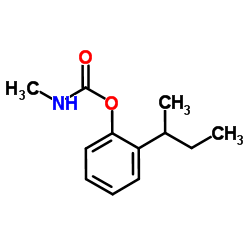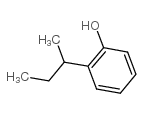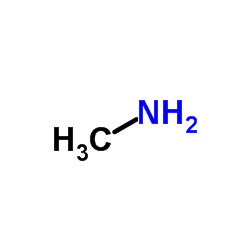Fenobucarb

Fenobucarb structure
|
Common Name | Fenobucarb | ||
|---|---|---|---|---|
| CAS Number | 3766-81-2 | Molecular Weight | 207.269 | |
| Density | 1.0±0.1 g/cm3 | Boiling Point | 282.5±23.0 °C at 760 mmHg | |
| Molecular Formula | C12H17NO2 | Melting Point | N/A | |
| MSDS | Chinese USA | Flash Point | 124.7±22.6 °C | |
| Symbol |


GHS07, GHS09 |
Signal Word | Warning | |
Use of FenobucarbFenobucarb is an extensively used carbamate insecticide. Fenobucarb induces zebrafish developmental neurotoxicity through pathways involved in inflammation, oxidative stress, degeneration and apoptosis. Fenobucarb is a possible risk factor to cardiovascular and cerebrovascular systems in animals[1][2]. |
| Name | fenobucarb |
|---|---|
| Synonym | More Synonyms |
| Description | Fenobucarb is an extensively used carbamate insecticide. Fenobucarb induces zebrafish developmental neurotoxicity through pathways involved in inflammation, oxidative stress, degeneration and apoptosis. Fenobucarb is a possible risk factor to cardiovascular and cerebrovascular systems in animals[1][2]. |
|---|---|
| Related Catalog | |
| References |
| Density | 1.0±0.1 g/cm3 |
|---|---|
| Boiling Point | 282.5±23.0 °C at 760 mmHg |
| Molecular Formula | C12H17NO2 |
| Molecular Weight | 207.269 |
| Flash Point | 124.7±22.6 °C |
| Exact Mass | 207.125931 |
| PSA | 38.33000 |
| LogP | 3.04 |
| Vapour Pressure | 0.0±0.6 mmHg at 25°C |
| Index of Refraction | 1.505 |
| InChIKey | DIRFUJHNVNOBMY-UHFFFAOYSA-N |
| SMILES | CCC(C)c1ccccc1OC(=O)NC |
CHEMICAL IDENTIFICATION
HEALTH HAZARD DATAACUTE TOXICITY DATA
|
| Symbol |


GHS07, GHS09 |
|---|---|
| Signal Word | Warning |
| Hazard Statements | H302-H410 |
| Precautionary Statements | P273-P501 |
| Personal Protective Equipment | dust mask type N95 (US);Eyeshields;Faceshields;Gloves |
| Hazard Codes | Xn: Harmful;N: Dangerous for the environment;T: Toxic;F: Flammable; |
| Risk Phrases | R22;R50/53 |
| Safety Phrases | S60-S61-S45-S24-S16-S7 |
| RIDADR | UN 2811 |
| RTECS | FB5425000 |
| Packaging Group | III |
| Hazard Class | 6.1(b) |
| HS Code | 2922499915 |
| HS Code | 2924199090 |
|---|---|
| Summary | 2924199090. other acyclic amides (including acyclic carbamates) and their derivatives; salts thereof. VAT:17.0%. Tax rebate rate:13.0%. . MFN tariff:6.5%. General tariff:30.0% |
|
QSAR study on permeability of hydrophobic compounds with artificial membranes.
Bioorg. Med. Chem. 15 , 3756-67, (2007) We previously reported a classical quantitative structure-activity relationship (QSAR) equation for permeability coefficients (P(app-pampa)) by parallel artificial membrane permeation assay (PAMPA) of... |
|
|
The role of methanol addition to water samples in reducing analyte adsorption and matrix effects in liquid chromatography-tandem mass spectrometry.
J. Chromatogr. A. 1389 , 76-84, (2015) Liquid chromatography-tandem mass spectrometry (LC-MS/MS) analysis coupled simply with water filtering before injection has proven to be a simple, economic and time-saving method for analyzing trace-l... |
|
|
[Effects of rice cleaning and cooking process on the residues of flutolanil, fenobucarb, silafluofen and buprofezin in rice].
Shokuhin Eiseigaku Zasshi 44(1) , 7-12, (2003) We studied the effect of cleaning and cooking on the residues of flutolanil, fenobucarb, silafluofen and buprofezin in rice. The rice had been sprayed in a paddy field in Wakayama city, with 3 kinds o... |
| (RS)-2-sec-butylphenyl methylcarbamate |
| Fenobucarb |
| Phenol, 2-(1-methylpropyl)-, methylcarbamate |
| Carvil |
| EINECS 223-188-8 |
| Fenocarb |
| (2-butan-2-ylphenyl) N-methylcarbamate |
| 2-sec-Butylphenyl methylcarbamate |
| Bassa |
| 2-(1-methylpropyl)phenyl methylcarbamate |
| Osbac |
| rac-2-[(2R)-butan-2-yl]phenyl methylcarbamate |
| Baycarb |
| Hopcin |
| O-(sec-butyl)phenyl N-methylcarbamate |
| fenobcarb |
| 2-sec-butyl-phenyl N-methyl-carbamate |
| 2-(butan-2-yl)phenyl methylcarbamate |
| MFCD00053081 |
| Barizon |
| BPMC |
| 2-(1-methylpropyl)phenyl N-methylcarbamate |
| 2-(Sec-butyl)phenyl methylcarbamate |
 CAS#:89-72-5
CAS#:89-72-5 CAS#:6642-30-4
CAS#:6642-30-4 CAS#:124-38-9
CAS#:124-38-9 CAS#:74-89-5
CAS#:74-89-5 CAS#:61005-12-7
CAS#:61005-12-7
